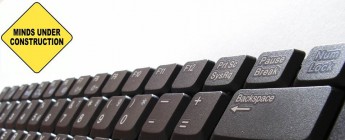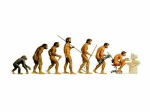We have heard of technology continuously evolving and being shaped to meet the requirements of us ever-demanding humans. This video, however, adds a new dimension to this perspective – that of humans evolving to adapt to technology.
Each passing year introduces us to paradigm shifts in the way we do things, because of newer technology being introduced. Little do we realize that we too are evolving to adapt to technology. In particular, the reference is being made to the gestures and rituals that technology forces us to adopt, and we do it so unconsciously. that it take a video like this to make us realize it.
To quote an example, think about this – In the olden days, when there was no telephone, the only time that a man would be required reach up to touch his ear would be to either scratch it, or clean it, or perform some similar action. The advent of the fixed land-line telephone increased the frequency of this action, because each time one needed to use the phone, one would have to do so. Then came the era of speaker-phones, so this action was reduced, and in some cases, replaced with poking with the finger to press a button. The old telephone also required a circular motion by the finger to dial a number. The digital phone instrument changed this to a pressing action by the finger, which was then replaced by the touch technology. The advent of the mobile phone these days has people constantly holding their phones to their ears and talking away for several hours a day. Which means that for many people, holding their hand up to their ear would become a second nature without even being aware of it.
The opening scene of this video has the girl lying on the bed, staring up at the ceiling with dark glasses which, then becomes apparent, are a device like Google Glass and she is watching some show on it. Here, the posture of sitting while watching something on a screen has been replaced with lying flat on a bed . Then the gesture of moving the glasses up and down, resulting in pausing and resuming of the entertainment.
Cut to the next scene, and you would expect the girl to unlock the car by using either a key or a remote device, but no, that has been replaced by a touch technology where she has to touch the window of the car and move her hand in a particular manner for the car to recognize her and the lock to open. Here one sees her struggling with it initially as she cannot get it right the first time, then manages to get it right.Next, to get the ignition going, she has to let the car “identify” her facially, through the rear-view mirror. But no, the mirror doesn’t like Ms Plain-Jane, or so it would appear. She just HAS to get her make-up right before it acknowledges her as an authorized driver and the ignition works. And mind you, she had better look her best EACH time she wants to drive, or else the car will not budge. After all, the car likes to have its driver looking her best.
The touch-less interaction with the phone was not much of a surprise however. Voice-controlled dialing does exist, after all. But yes, here too she has to make several attempts to get her pronunciation right before the phone would understand her. “Dumb” phone can’t get it right in the first attempt ! And even when it does get the call through, the call disconnects half-way through, thus causing the girl to practice her pronunciation skills once again in order to connect a second time. Smart phones of the future don’t appear to be much smarter than they are today.
The closet scene is, perhaps, the most unbelievable of all. The closet will not oblige by opening up till she stands on the tips of her toes a couple of times, tilts her head a couple of times, before she is recognized and given access. And then we have our leading lady standing before the closet, waving her hand in the air from the right to the left, as if pushing aside clothes hangers in the closet to inspect dresses, and with each wave of the hand, the closet is giving synthesized-voice suggestions on what she could wear. But mind you, it take a rap on the side from the lady before it can come up with the right suggestion. My apologies if I sound like a MCP, but if this technology was ever introduced, it would probably have to be AC Powered, or run on very strong batteries, and one can only imagine the number of hand motions it would induce every day ! 😀
But my favourite part of the video is the social interaction between the two people, although I still cannot figure out why the girl needs to put on her Google-Glass-Like gadget during the interaction and the purpose that it was serving. Was it helping her to organise her thoughts ? Helping her focus ? Was she recording the interaction through the gadget ? And yet she managed to get distracted by the dog outside.
And then, almost as though he too wanted to have a gadget handy, her male friend also pulls out his cellphone, which, unfortunately, like the cellphones of today, was running out of battery. A mere mortal like us in today’s day and age would be aghast at such a development, but not our hero of tomorrow’s world. No sir. They do not need chargers. All that they have to do is hold the gadgets and make circular motions in the air with their hands. And so you have both of them doing that with their respective gadgets till they are fully recharged. Another example of man’s unconscious adaptation to technology.
And while they are both still busy making circular motions with their hands – something that may seem funny and out of place to us – the man sitting on the next table, reading a good old-fashioned book, does not even look up. The implication is startling, to say the least. And the implication is that we humans adapt to technology and alter our gestures and rituals to do so, almost as if it is the most natural thing on earth to do. And when we do adapt to it, no one even gives it a second glance because it is no longer something out of place.
Another not-to-be-missed fact was the syncing of thoughts with the handheld device. But alas, the device has reception problems in a noisy environment, much like the disturbances that interfere with signals on our current-day gadgets. So our man has to find a quiet place to do his thought syncing, and what better place could be there than the washroom ? Our man walks in, locks himself up, and is syncing in peace till he gets a rap on the door from the outside. He is not the only one with the idea of using the washroom – there is a whole queue waiting outside. In our times too, we see such queues outside public washrooms, but these are made up of people waiting to answer the call of nature, with varying degrees of urgency. In the queue seen outside in this video too, the varying degrees of urgency can be seen, BUT for a different reason altogether, which, perhaps to them is no less important !
The video also highlights the fact that even future technology is far from perfect. The struggle to get things right will, perhaps, continue in the future as well. And so will our frustrations. And since frustrations with technology are normal, life will continue normally.
Welcome to the future.





